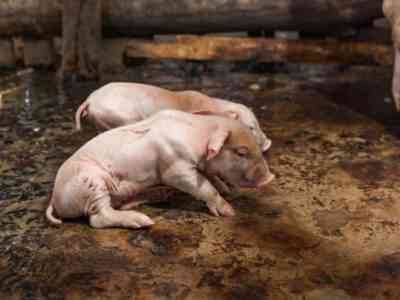4 Practical Steps for a Pathogen Free Environment on Your Pig Farm
Hygiene is essential for optimal animal health and a crucial part of your health management. A pathogen free living environment for fattening pigs is essential and can be achieved with the HyCare method.
 Learn More
Learn MoreThe HyCare method is based on 4 pillars:
pore-free floors and walls
a clean stable by thorough cleaning and disinfection after each round
preventive pest control
clean and germless drinking water.
Furthermore, good external and internal biosecurity are necessary. Pig farms that have implemented all these steps will be supervised by MS Schippers to maintain the HyCare method. This method achieves goals such as improved health, higher growth and feed conversion and less antibiotic use (up to 100% reduction). The good news is; due to the low-threshold, the method can easily be used in any pig stable without high investments.
The 4 HyCare pillars
Pore-free floors and walls
Concrete is a widely used product in pig farms worldwide. The disadvantage of concrete is that it is often porous and allows micro-organisms to nest in the pores, flakes and tears of the walls and floors. For example, lime sandstone can absorb up to 450 ml of water/pathogens in a single brick, while it appears apparently clean and dry. The penetration of micro-organisms can be prevented by applying a plastic coating over the floors and walls. In addition, the floors and walls are also easier and more hygienic to clean and disinfect.
A clean stable
A healthy living environment is very important for pigs. In hygienic animal housing, they stay fit and vital and this will positively improve the production/economic results. Newborn animals are also given the chance to make a good start without being infected directly at birth by a filthy environment. This means that both the stable and all materials must be clean. It allows pigs to focus all their energy on performance instead of disease control. To kill pathogens it is important to clean first and then disinfect.
It seems like a time-consuming job, but it is very important for the well-being of your animals. With healthier animals, you actually save time. When applying the steps correctly, you reduce the pathogen pressure significantly.
READ ALSO: How to Keep Pigs Healthy During Weaning
Preventive pest control
Flies, rats, mice and other vermin are huge disease transmitters in pig farms. They can cause major inconvenience for both pigs and farmer. Effective control is useful and this already begins with maggot control in the fertiliser pit. It can be a time-consuming and not always easy job, but this could be outsourced to MS Schippers who has a professional team of pest controllers on stand-by.
ATTENTION: Click “HERE” to receive More updates directly on your WhatsApp!
Clean and germless drinking water
The importance of the quality of drinking water is often underestimated, yet water is the most important nutrient for animals. Animals consume more water (66%) daily than food (33%). Poor water quality can have serious consequences on the health of the pigs and costs the livestock farmer a great deal of money. To maximise the performance of pigs, it is important that they have access to clean, healthy drinking water. Water is necessary for vital biological functions like growth, body temperature, the transport of foodstuffs and waste in the body.
One of the most significant causes of contaminated drinking water is a biofilm in the water supply. Cleaning this is necessary to prevent the formation of biofilm, which occurs through the accumulation of iron, manganese, calcium, and various additives to the water, like medication. A typical property of biofilm is that many illnesses (E. Coli, Salmonella, Clostridium, Streptococcus, Staphylococcus, Campylobacter, etc.) can survive and grow inside it.
READ ALSO: How Farmers Married Out Daughters for Loan Repayment
The importance of hygiene
Dr Godfried Groenland, veterinarian at De Heus Animal Feed, has been working in livestock farming for 29 years. He has conducted serology and manure research on 30 farms and has concluded that there is a direct effect between hygiene and serology. Furthermore he claims that the improvement in serology and manure is proportionate to the improvement in growth. Groenland measured infections per illness:
Salmonella
Lawsonia
Circovirus
Illnesses that are also spread through manure, in the pen, and on the grates. It appears that if you clean really well, the chance that such illnesses occur is much smaller and the technical results are much better.
“It is a pity to move a piglet with no illnesses to a poorly cleaned department at 10 weeks. We then see positive serological test results around 3-4-5 weeks, or we register a high number of intestinal pathogens. You also see that the technical results on these farms are getting worse,” says Dr Groenland. “In the research carried out by De Heus at 30 farms, we see that there is a 150g difference between farms that have had many infections in the fattener department and farms that have had very few infections.”
In the research they also looked at the way in which cleaning and disinfection occurred. The farms can be classified as:
farms where absolutely nothing was done
farms that only clean with water
farms that cleaned with water and then degreased or disinfected
farms that cleaned with water and then degreased as well as disinfected
Salmonella, Lawsonia (also called Pia) and circovirus in accordance with the level of cleaning and disinfection. The better the cleaning and disinfection, the fewer positive serology results occurred at these farms in the first five weeks. Thus, we see a direct effect on the reduction of all these infections from cleaning and disinfection.















